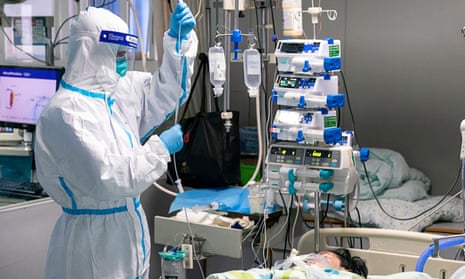There are no vaccines or treatments approved for the new coronavirus, but the race is on to develop one.
This week the Coalition for Epidemic Preparedness Innovations (Cepi) announced it would commit $11m (£8.4m) to three programmes led by the companies Inovio Pharmaceuticals, Moderna and the University of Queensland.
Cepi, which is funded by several countries and philanthropic donors, was set up three years ago in the wake of the Ebola epidemic, which killed 11,000 people. Despite an Ebola vaccine (later shown to be almost 100% effective) having been in development for a decade, it was not deployed until more than a year into the epidemic.
This time the aim is to have a viable vaccine in production within as little as 16 weeks – although testing for safety and efficacy will take longer.
One advantage is that the new coronavirus, 2019-nCoV, belongs to the same family as the severe acute respiratory syndrome (Sars), for which a vaccine was developed following the 2002 outbreak. “Certainly that information will give us a head start,” said Prof Brendan Wren, dean of the faculty of infectious and tropical diseases at London School of Hygiene and Tropical Medicine (LSHTM).
According to Wren vaccine technology has also advanced significantly since the Sars outbreak. Traditional vaccines work by developing an attenuated version of a virus – one that looks similar enough that the body’s immune system will recognise the real version in the future. But the latest efforts will use entirely different approaches. “They’re all new technologies and have a lot of promise for being able to do things very rapidly,” said Richard Hatchett, CEO of Cepi.
One of the teams is working on a so-called DNA vaccine. The aim is to find the specific stretch of DNA that codes for the receptor on the virus’ surface that allows the immune system to target it. In theory, if this DNA is injected into a person, it should enter their cells, which would start churning out proteins that look exactly like the receptor on the surface of the virus. These little floating receptors would then trigger the immune system without causing any illness.
Even if a viable vaccine is found quickly, it will still need to go through further months of testing, careful decisions would need to be made about who should be vaccinated – health workers are typically the first in line. “Even if you’ve got a relatively rare side effect you have to worry about that if you’re vaccinating millions of people,” said Prof Peter Smith, an epidemiologist at LSHTM.
Whether a vaccine will ever need to be deployed is an open question. Sars was brought under control with public health measures, and possibly because it mutated into a less virulent strain. The vaccine was shelved and never licensed.
“When you have a new outbreak that moves as quickly as this one has you have to use the precautionary principle,” said Hatchett. “You don’t want to wait until you’re in a situation where you know you need a vaccine to begin making one.”
